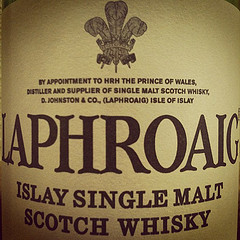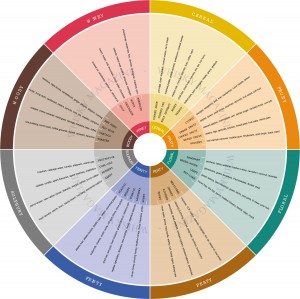
Simon Brooking, North America Brand Ambassador for Laphroaig, with Gary & friends
It sounded like a fantastic event and they even had a chance to check out the 2014 Cairdeas – I absolutely fell in love with the 2013 Cairdeas and polished off several bottles (Triple Wood is delicious too!). I think they were made a little smaller because they disappeared fast. 🙂
Here’s more about the event from Gary himself:
We walked into the tasting room and the first thing that hits you is smoke. A lot of smoke. All the tasting were already poured, 6 per person.
This night we got to taste the Select, 10yo, Quarter cask, Triple wood, 18yo and finished with the Cairdeas from 2014.
Simon greeted us all and then started out with a song. Then he started in with the history of Laphroiag, and how they became a legal distillery in 1815, but they had been distilling illegally for a while. Simon did not say exactly how long the illegal part was going on, but it was for “some time”. Simon then went on to explain how to nose the whisky and how having your mouth open is important, as it allows you to get more aromas and not just the alcohol coming out of the glass.
We started with the Select, which I liked very much. The select is a blend of the 10yo, the Quarter cask,Triple wood, and PX. A good place to start since the select does not have the typical heavy smoke nose or antiseptic tastes that the 10yo has. Still some smoke on the nose, some fruit, smooth, not too much peat at the end. And Simon does a toast with every dram. Some toasts are in Gaelic, some in English and one in Spanish.
Simon then produced a piece of peat, nice big chunk. He explained how the peat was used to dry the barley, and how the peat smoke added that unique flavor to the barley. Simon also explained how they farmed the peat.
They go down 9 inches, put that to the side, then go 18 inches put that to the side, and then use the next 18 inches. Put the first two pieces back, which makes the whole process more sustainable, and you get a more consistant flavor of peat digging so deep.
Simon then proceed to start the peat to smoking and let us all get a good whiff of the smoke. It was also discussed that some people use the peat to smoke fish or meats, and that if you get some of the barley that has been dried it makes an excellent batter for food, get some nice smokey flavor.
We then went to the 10yo which I liked very much. Smoke just pouring out of the glass, taste of a camp fire in the mouth, then floral, antiseptic, then more smoke. Long finish but very enjoyable. With a bit of water the floral, fruity notes really pop out.
After the 10yo we tried the Quarter Cask.Not nearly as smokey as the 10yo. Still nice but the oak really comes into play. Many of the others liked this quite a bit, but not my favorite.Then more information. Such as it can get very dry during the summer and the water supply for Laphroaig can dry up. So if you are planning a summer trip to see the distillery and see them actually making alcohol you probably should call first. They may be waiting for rain to fill up the lake.
Also the 18yo will not be offered next year. It seems that is already happening since many of the local stores here have no 18. Other than Costco. Laphroaig will be offering a 15yo in 2015. They just don’t have the stocks which makes sense due to the demand for single malts.
Okay so scotch, Triple wood was next on the tasting. Less smoke, alot more mouth feel, oak of course, and nice finish.
Then the 18yo. Where did all the smoke go? Not nearly as much peat in the nose or the palate. Much more of the floral fruity notes, easy to drink, medium finish. My sons like this one quite a bit.
Finished up with the Cairdeas. Wow nice scotch. Aged in oak and then finished for a year in Amontillado hoghead sherry cask. Not your typical Laphroaig. Smoke, sherry, complex for sure, very pleasant, smooth. Great way to finish the evening. A little tip from Simon, if you aren’t sure what year Cairdeas you have look at the ABV. Last year it was 51.3%, this year is 51.4% so next year should be 51.5%.
Laphroaig is 200 next year, (legally) and they plan on having a big celebration during Feis Ila, but are planning on a second celebration since they feel so many people are wanting to come to the distillery and take part in the anniversary.
Other note Laphroaig uses only Makers Mark barrels to age their alcohol. They feel Maker Mark fits the best with their alcohol.
we scored some nice swag from Laphroaig, and heavy duty pen, a stainless steel flask, plus a wonderful spread of bread, meats and cheeses during the tasting. Even have a photo with Simon and a few bottles he signed for us.Laphroiag really does it up right. If there is a tasting in your area it really is worth checking out!
Sounds like a fun event worth way more than $10!


